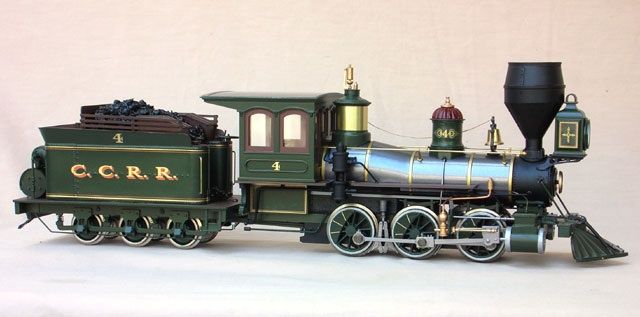

This is is a large scale model of a Porter 2-6-0, built on a Bachmann mechanism. I love everything about it, from the fancy cab to the fluted dome.
Jeff C
|




|


This is is a large scale model of a Porter 2-6-0, built on a Bachmann mechanism. I love everything about it, from the fancy cab to the fluted dome.
Jeff C
Replies sorted oldest to newest
Maybe SMR ( I think it is right spelling ![]() would possibly do one. They have been making engines from the 1800's. Send them an email...........Paul
would possibly do one. They have been making engines from the 1800's. Send them an email...........Paul
I like SMR, but I'd like to see more small locos like this available at non-brass price points.
Jeff C
The SMR stuff is fantastic.....but yes.....I'd like to see locos like this in the WbB 4-6-0 price range.
You can get close in On30.....but a standard gauge would be nice.....
This started as a Bachmann starter set loco. I changed domes, stack, pilot and tender,,,,paint and my own decals.
There is another thread on this forum "What hasn't been made yet*** but would sell". This thread has gone to four pages and any many ways has devolved to "What I would like from Santa" instead of what would sell.
IMHO (In my humble opinion) small locomotives would fill a need, especially 2-8-0s, 2-8-2s, and 4-4-0. Particularly if they looked like early twentieth century locomotives.
The 2-6-0 you show is a good example of what I have in mind, particularly if they had a low priced point.
My advocacy is that a small locomotive can be run on large and small layouts, they can be operated with large scale turns or tight turns and they accentuate the larger locomotives. This would provide a much larger market than what exists for say a Big Boy.
The tooling for small locomotives could also be modified to use on starter sets and entry level equipment this would allow larger manufacturing numbers and lower costs.(think economy of scale)
Your locomotive looks great.
Douglas
I guess "C.C." stands for Colorado Central, which I think was three foot narrow gauge.
The stack looks like that on Denver, South Park, and Pacific locos, also three foot.
The Colorado Midland and others, including D&RG(W) had standard gauge tea kettles
that I would buy as models...but...here we go again...
There is another thread on this forum "What hasn't been made yet*** but would sell". This thread has gone to four pages and any many ways has devolved to "What I would like from Santa" instead of what would sell.
IMHO (In my humble opinion) small locomotives would fill a need, especially 2-8-0s, 2-8-2s, and 4-4-0. Particularly if they looked like early twentieth century locomotives.
The 2-6-0 you show is a good example of what I have in mind, particularly if they had a low priced point.
My advocacy is that a small locomotive can be run on large and small layouts, they can be operated with large scale turns or tight turns and they accentuate the larger locomotives. This would provide a much larger market than what exists for say a Big Boy.
The tooling for small locomotives could also be modified to use on starter sets and entry level equipment this would allow larger manufacturing numbers and lower costs.(think economy of scale)
Your locomotive looks great.
Douglas
Sorry, didn't mean to give the impression this beautiful loco is mine--it was featured in a large scale forum.
Jeff C
I guess "C.C." stands for Colorado Central, which I think was three foot narrow gauge.
The stack looks like that on Denver, South Park, and Pacific locos, also three foot.
The Colorado Midland and others, including D&RG(W) had standard gauge tea kettles
that I would buy as models...but...here we go again...
I think Porter built both narrow gauge and standard gauge versions of this era 2-6-0.
Jeff C
Oh yes! that would be nice.
I'm not holding by breath though, but if it happens . . . ![]()
I would love to see a loco like this but for me to purchase, it must be O scale and not the oversize of the Railking or Lionel traditional 4-4-0s.
Access to this requires an OGR Forum Supporting Membership
